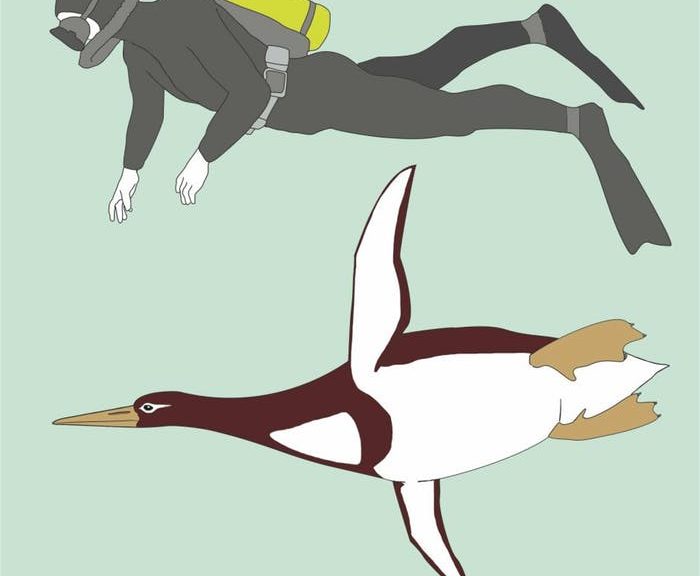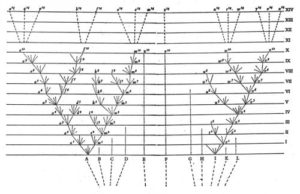
“EVOLUTION” DID NOT INTERVENE ON ‘MONSTER’ PENGUINS
Let’s take a look at an article published on December 13, 2017 entitled “Evolution intervened on ‘monster’ penguins” in USA Today:
“Talk about your big bird. Scientists on Tuesday announced the discovery of a new species of an ancient giant penguin, one that was nearly 6 feet tall and weighed about 220 pounds, roughly the same height and size as an average man.
Fossilized remains of the extinct penguin were discovered in the Otago region on New Zealand’s South Island. The new species is named Kumimanu biceae: In the Maori language of New Zealand, Kumi means “monster,” and manu is the word for “bird.”
The penguin lived about 55 million years ago, scientists say, so the fossils help provide clues to the early evolution of penguins.
“We examined the wing and leg bones of this penguin and quickly realized that we were looking at a previously unknown species,” said Gerald Mayr, a paleontologist at the Senckenberg Re- search Institute in Frankfurt and lead author of the study.
It is also one of the oldest known penguin species; only two other species are known from as far back as 62 million to 58 million years ago.
“The fossil species is not directly ancestral to any of the modern species,” he said, adding that the giant penguins became extinct without leaving any direct descendants.
When the species lived, there were very few potential predators in the seas around New Zealand. Large marine mammals — such as toothed whales and seals — had not evolved, so the only predators probably were sharks, Mayr said.
Other large marine predators soon appeared, so the penguins faced new competition and predation — which may have led to their extinction. Therefore, penguins did not get smaller as they evolved. The smaller species lived together with the large penguins, but only the descendants of the smaller penguins survive today.
The scientists assume the penguins’ gigantism was a result of the seabirds’ flightlessness. Like penguins today, they were not able to fly: “It was certainly perfectly able to swim and walk on land but probably spent most time in the water,” Mayr said.
As for its diet, this new penguin species was probably a fish eater and sported long, spear-like beaks. The study was published in Nature Communications, a peer-reviewed British journal.”

Newly discovered, but now extinct, large penguins are some of the latest proofs that the Darwinian evolutionary theory is bunk. According to their macro-evolutionary assertions, things start small and work up the evolutionary chain, the so-called survival of the fittest. The only problem is, these ancient, extinct penguins are much larger than any modern-day penguins. To sidestep the obvious problem of this discovery debunking their sacred Darwinism, that the exact opposite occurred in this case, evolutionists claim that modern-day penguins did not descend from these ‘monster’ extinct penguins. In claiming this, they still cut their own evolutionary throat. How? They are proving inadvertently that all things did not evolve from common ancestors. In other words, they are admitting that all penguins did not evolve from the same ancestor. There was no survival-of-the-fittest. Darwinism is a charade.
When Darwin wrote The Origin of the Species, the oldest known fossils were from a geological period known as the Cambrian, named after rocks in Cambria, Wales. But the Cambrian fossil record doesn’t start with one or a few species that diverged gradually over millions of years into genera, then families, then orders, then classes, then phyla. Instead, most of the major animal phyla—and many of the major classes within them—appear together abruptly in the Cambrian, fully formed.
According to modern paleontologists James Velentine, Stanly Aerick, Philip Signor, and Peter Sadler, the appearance of the animal phyla near the beginning of the Cambrian is “the single most spectacular phenomenon evident in the fossil record.” The phenomenon is so dramatic that it has become known as the “Cambrian explosion,” or “biology’s Big Bang.” Valentine and his colleagues agree that the Cambrian explosion “is real; it is too big to be masked by flaws in the fossil record.” Indeed, as more fossils are discovered it becomes clear that the Cambrian explosion was “even more abrupt and extensive than previously envisioned.”
So the major phylum-level differences that Darwin predicted would appear in the last fossil record actually appeared first. Instead of proceeding from the bottom up, it seems that animal evolution—in the words of Valentine and his colleagues—”has by and large proceeded from the ‘top down’.” Paleontologist Harry Whittington, who pioneered the modern study of the Cambrian explosion in the Burgess Shale of Canada, wrote in 1985: “I look skeptically upon diagrams that show the branching diversity of animal life through time, and come down at the base to a single kind of animal… Animals may have originated more than once, in different places and at different times.”
“God created the great creatures of the sea and every living thing with which the water teems and that moves about in it, according to their kinds, and every winged bird according to its kind. God made the wild animals according to their kinds.”—Genesis 1:21,25 NIV
Whichever “kind” that God made Penguins in, they also descend according to their “kinds.” The Bible, while not written to be a science textbook, nevertheless tells the true story, brief though it is.